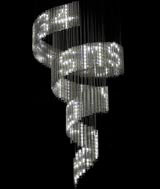Star-struck
Subtle lighting schemes are now commonplace, so designers are creating flamboyant concepts that make a bold impression rather than blend into the background, says Miriam Cadji

Stein approached Kate Williams, an artist who works with light, to collaborate on the piece. ‘He wanted to create the effect of an exploded meteorite in the air and didn’t know how to make it happen,’ she says. Williams set about piercing amber nuggets and threading them on to the ends of fibre optics. ‘Despite some of them being quite chunky, the resin pieces are surprisingly light – the fibre optics were easily able to tolerate their weight,’ she explains. The strands were then integrated into a ceiling panel, behind which the bundles of fibre optics run into a light engine, located remotely for ease of maintenance and to ensure diners are not disturbed by a noisy fan.
The results proved so popular (a few of the amber pieces were even pocketed by diners keen for a souvenir) that the client insisted on repeating the concept at Chez Kristof, which opened in London’s Hammersmith this summer. Although similar in execution, the scale of the later installation is more modest, to suit the smaller interior. Less of a sphere than the first, the architect and artist agreed the finished piece shouldn’t look too uptight. ‘If you’re sitting beneath it, it’s like looking up at raindrops, but frozen – it’s really dynamic,’ says Stein. The finished light contains 150 pieces of amber and has been prominently positioned above a circular banquette that has become – unofficially – known as the ‘bling’ table.
Elsewhere, and equally ‘bling’, is United Designers’ lighting for London restaurant, Pearl. Formerly the banking hall of a sober institution, Pearl Assurance, in its latest incarnation as a bar and restaurant it’s out and it’s proud. A glamorous, high-camp cylindrical chandelier dripping with pearls and glass beads, designed by United Designers, hangs from the ornate ceiling of the Grade II-listed interior. ‘It’s a definite crowd pleaser – it’s what people take away with them after a special night out,’ admits United Designers’ creative director Ian Baylis, who was responsible for the refurbishment.
Ironically, the chandelier was a compromise that arose out of a clash with planners, who banned the original design – a top-lit horizontal string of pearls running the length of the space. ‘We were told we couldn’t touch the ceiling – our hands were tied,’ says Baylis. Reluctantly forced to re-use the original fixture outlets, a collective groan went around the office. ‘We wanted an overtly sexy interior without alienating the core clientele of serious lawyers,’ he explains. ‘Pearl is quite a masculine space – it’s huge and fairly overbearing, and as such it would have been our worst nightmare to come on-site and find a tiny, tasteful fitting.’
‘We knew that it had to be bigger and glossier by about 20 per cent just to compete with the architecture, so we had some fun. The space dictated that it should be over the top – our style is generally more pared back,’ he adds.
The result has generated a lot of interest, and has helped land the group its latest job: refurbishing a five-star hotel in central London. Currently at concept stage (due to complete in summer 2006), the lighting design takes its cue from Pearl. ‘It’s a similar philosophy: a grand building with the same atmosphere in terms of detailing and scale,’ says Baylis. ‘We’re aiming for ‘high luxury’, but with a contemporary twist.’ The ideas that have emerged are a clear progression from the Pearl chandelier – long curtains of fringed glass beads are arranged in horizontal formation above the bar, and in square and cylindrical forms suspended over key tables in the restaurant, to create intimacy and punctuate a cavernous space. There’s nothing discreet about it.
-
Post a comment




